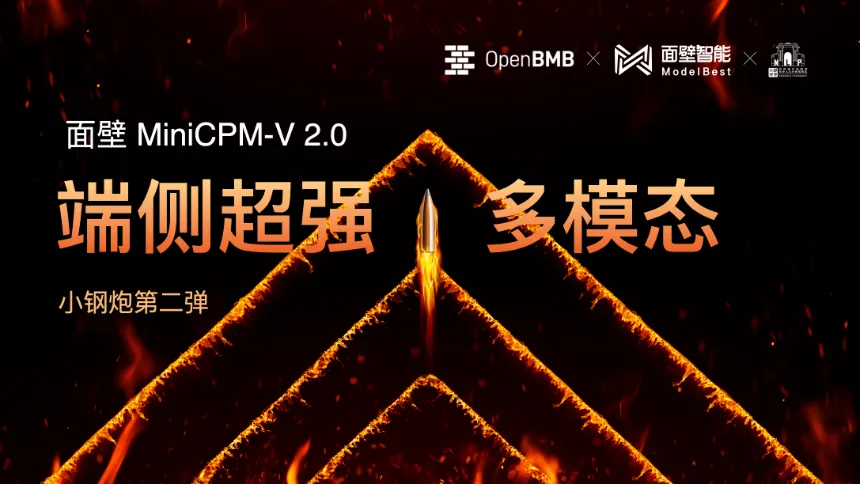 作者:姚远*、余天予、王崇屹、崔竣博、朱宏吉、蔡天驰、赵威霖、张开活、洪亦歆、李好雨、胡声鼎、郑直、周界、蔡杰、贾超、韩旭、曾国洋、李大海、刘知远*、孙茂松
作者:姚远*、余天予、王崇屹、崔竣博、朱宏吉、蔡天驰、赵威霖、张开活、洪亦歆、李好雨、胡声鼎、郑直、周界、蔡杰、贾超、韩旭、曾国洋、李大海、刘知远*、孙茂松
机构:面壁智能,清华大学自然语言处理实验室
▾ 项目地址
▾ 模型地址
简介
我们推出 MiniCPM 系列的最新多模态版本 MiniCPM-V 2.0。该模型基于 MiniCPM 2.4B 和 SigLip-400M 构建,共拥有 2.8B 参数。MiniCPM-V 2.0 具有领先的光学字符识别(OCR)和多模态理解能力。该模型在综合性 OCR 能力评测基准 OCRBench 上达到开源模型最佳水平,甚至在场景文字理解方面实现接近 Gemini Pro 的性能。
MiniCPM-V 2.0 值得关注的特性包括:
-
领先的 OCR 和多模态理解能力。MiniCPM-V 2.0 显著提升了 OCR 和多模态理解能力,场景文字理解能力接近 Gemini Pro,在多个主流评测基准上性能超过了更大参数规模(例如 17-34B)的模型。
-
可信行为。MiniCPM-V 2.0 是第一个通过多模态 RLHF 对齐的端侧多模态大模型(借助 RLHF-V [CVPR'24] 系列技术。该模型在 Object HalBench 达到和 GPT-4V 相仿的幻觉水平和可信表现。
-
任意分辨率高清图像高效编码。 MiniCPM-V 2.0 可以接受 180 万像素以下任意长宽比图像输入(基于最新的 LLaVA-UHD 技术),这使得模型可以感知到小物体、密集文字等更加细粒度的视觉信息。
-
高效部署。MiniCPM-V 2.0 可以高效部署在大多数消费级显卡、个人电脑以及移动手机等终端设备。
-
双语支持。MiniCPM-V 2.0 提供领先的中英双语多模态能力支持。该能力通过 VisCPM [ICLR'24] 论文中提出的多模态能力的跨语言泛化技术实现。
全面测评
我们将 MiniCPM-V 2.0 与包括 Qwen-VL-Chat 10B、DeepSeek-VL-7B 和 CogVLM-Chat 17B 在内的几款前沿多模态大模型进行了比较,发现即便与参数规模更大的多模态大模型相比,MiniCPM-V 2.0 也展现出了优秀的性能。

MiniCPM-V 2.0 在多个评测基准上与其他模型得分的雷达图

多个OCR评测基准上MiniCPM-V 2.0与其他模型的得分、参数
MiniCPM-V 2.0 拥有优秀的场景文字和文档理解能力。在涵盖了多个领域和任务的综合性 OCR 评测基准 OCRBench 上,MiniCPM-V 2.0 取得了开源模型中最先进的性能。同时,在主流通用场景文字理解评测基准 TextVQA 上,MiniCPM-V 2.0 的表现甚至与 Gemini Pro 相当。

MiniCPM-V 2.0在主流多模态通用能力评测基准的得分
为了考察通用多模态理解能力,我们评测了 MiniCPM-V 2.0 在 OpenCompass 的表现。OpenCompass 是一个综合性评测榜单,涵盖了 11 个主流多模态大模型评测基准,包括 MME、MMBench、MMMU、MathVista 和 LLaVA Bench 等。
典型示例

MiniCPM-V 2.0 街景识别、长图识别和幻觉抵抗案例
我们将 MiniCPM-V 2.0 部署在小米 14 Pro 上,并录制了以下演示视频,视频未经剪辑。


推理示例
MiniCPM-V 2.0 可以被部署在大多数的消费级显卡、MPS (Apple silicon 或 AMD 显卡) 的 Mac 电脑以及安卓或者鸿蒙系统手机上。
常见显卡部署示例
from chat import OmniLMMChat, img2base64chat_model = OmniLMMChat('openbmb/MiniCPM-V-2.0')im_64 = img2base64('./assets/hk_OCR.jpg')# First round chatmsgs = [{"role": "user", "content": "Where should I go to buy a camera?"}]inputs = {"image": im_64, "question": json.dumps(msgs)}answer = chat_model.chat(inputs)print(answer)# Second round chat# pass history context of multi-turn conversationmsgs.append({"role": "assistant", "content": answer})msgs.append({"role": "user", "content": "Where is this store in the image?"})inputs = {"image": im_64, "question": json.dumps(msgs)}answer = chat_model.chat(inputs)print(answer)
# test.pyimport torchfrom PIL import Imagefrom transformers import AutoModel, AutoTokenizermodel = AutoModel.from_pretrained('openbmb/MiniCPM-V-2.0', trust_remote_code=True, torch_dtype=torch.bfloat16)model = model.to(device='mps', dtype=torch.float16)tokenizer = AutoTokenizer.from_pretrained('openbmb/MiniCPM-V-2.0', trust_remote_code=True)model.eval()image = Image.open('./assets/hk_OCR.jpg').convert('RGB')question = 'Where is this photo taken?'msgs = [{'role': 'user', 'content': question}]answer, context, _ = model.chat(image=image,msgs=msgs,context=None,tokenizer=tokenizer,sampling=True)print(answer)
使用以下命令运行:
PYTORCH_ENABLE_MPS_FALLBACK=1 python test.py安卓或鸿蒙系统手机部署示例
参考下方链接的教程进行部署 🚀。
🔗 https://github.com/OpenBMB/mlc-MiniCPM
总结
1. MiniCPM: Unveiling the Potential of Small Language Models with Scalable Training Strategies. 2024.
2. RLHF-V: Towards Trustworthy MLLMs via Behavior Alignment from Fine-grained Correctional Human Feedback. CVPR 2024.
3. LLaVA-UHD: an LMM Perceiving Any Aspect Ratio and High-Resolution Images. 2024.
4. Large Multilingual Models Pivot Zero-Shot Multimodal Learning across Languages. ICLR 2024.
One More Thing
